Related Research Articles

Influenza hemagglutinin (HA) or haemagglutinin[p] is a homotrimeric glycoprotein found on the surface of influenza viruses and is integral to its infectivity.

Orthomyxoviridae is a family of negative-sense RNA viruses. It includes seven genera: Alphainfluenzavirus, Betainfluenzavirus, Deltainfluenzavirus, Gammainfluenzavirus, Isavirus, Thogotovirus, and Quaranjavirus. The first four genera contain viruses that cause influenza in birds and mammals, including humans. Isaviruses infect salmon; the thogotoviruses are arboviruses, infecting vertebrates and invertebrates. The Quaranjaviruses are also arboviruses, infecting vertebrates (birds) and invertebrates (arthropods).
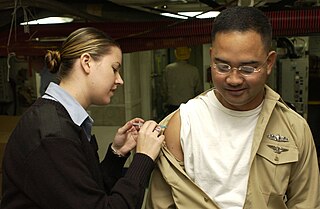
Influenza vaccines, also known as flu shots or flu jabs, are vaccines that protect against infection by influenza viruses. New versions of the vaccines are developed twice a year, as the influenza virus rapidly changes. While their effectiveness varies from year to year, most provide modest to high protection against influenza. The United States Centers for Disease Control and Prevention (CDC) estimates that vaccination against influenza reduces sickness, medical visits, hospitalizations, and deaths. Immunized workers who do catch the flu return to work half a day sooner on average. Vaccine effectiveness in those over 65 years old remains uncertain due to a lack of high quality research. Vaccinating children may protect those around them.
Virus-like particles (VLPs) are molecules that closely resemble viruses, but are non-infectious because they contain no viral genetic material. They can be naturally occurring or synthesized through the individual expression of viral structural proteins, which can then self assemble into the virus-like structure. Combinations of structural capsid proteins from different viruses can be used to create recombinant VLPs. VLPs derived from the Hepatitis B virus (HBV) and composed of the small HBV derived surface antigen (HBsAg) were described in 1968 from patient sera. VLPs have been produced from components of a wide variety of virus families including Parvoviridae, Retroviridae, Flaviviridae, Paramyxoviridae and bacteriophages. VLPs can be produced in multiple cell culture systems including bacteria, mammalian cell lines, insect cell lines, yeast and plant cells.

Influenza B virus is the only species in the genus Betainfluenzavirus in the virus family Orthomyxoviridae.
The NS1 influenza protein (NS1) is a viral nonstructural protein encoded by the NS gene segments of type A, B and C influenza viruses. Also encoded by this segment is the nuclear export protein (NEP), formally referred to as NS2 protein, which mediates the export of influenza virus ribonucleoprotein (RNP) complexes from the nucleus, where they are assembled.
Walter Fiers was a Belgian molecular biologist.
Hugo Van Heuverswyn is a Belgian molecular biologist, biotech pioneer, entrepreneur and businessman. He has been the chairman of the VIB, Flanders Institute for Biotechnology, since its inception in 1995.
The National Institute of Virology, Pune is an Indian virology research institute, and one of the translational science cells part of Indian Council of Medical Research (ICMR). It was previously known as 'Virus Research Center' and was founded in collaboration with the Rockefeller Foundation. It has been designated as a WHO H5 reference laboratory for SE Asia region.

The history of virology – the scientific study of viruses and the infections they cause – began in the closing years of the 19th century. Although Louis Pasteur and Edward Jenner developed the first vaccines to protect against viral infections, they did not know that viruses existed. The first evidence of the existence of viruses came from experiments with filters that had pores small enough to retain bacteria. In 1892, Dmitri Ivanovsky used one of these filters to show that sap from a diseased tobacco plant remained infectious to healthy tobacco plants despite having been filtered. Martinus Beijerinck called the filtered, infectious substance a "virus" and this discovery is considered to be the beginning of virology.
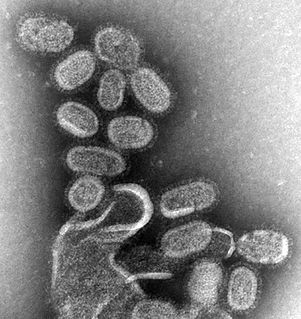
Influenza, commonly called "the flu", is an infectious disease caused by influenza viruses. Symptoms range from mild to severe and often include fever, runny nose, sore throat, muscle pain, headache, coughing, and fatigue. These symptoms typically begin 1–4 days after exposure to the virus and last for about 2–8 days. Diarrhea and vomiting can occur, particularly in children. Influenza may progress to pneumonia, which can be caused by the primary viral infection or by a secondary bacterial infection. Other complications of infection include acute respiratory distress syndrome, meningitis, encephalitis, and worsening of pre-existing health problems such as asthma and cardiovascular disease.
Adolfo García-Sastre,(born in Burgos, 10 October 1964) is a Spanish professor of Medicine and Microbiology and co-director of the Global Health & Emerging Pathogens Institute at the Icahn School of Medicine at Mount Sinai in New York City. His research into the biology of influenza viruses has been at the forefront of medical advances in epidemiology.

Peter Palese is a United States microbiologist and Professor and Chair of the Department of Microbiology at the Icahn School of Medicine at Mount Sinai in New York City, and an expert in the field of RNA viruses.
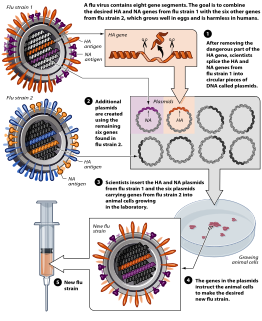
Reverse genetics is a method in molecular genetics that is used to help understand the function(s) of a gene by analysing the phenotypic effects caused by genetically engineering specific nucleic acid sequences within the gene. The process proceeds in the opposite direction to forward genetic screens of classical genetics. While forward genetics seeks to find the genetic basis of a phenotype or trait, reverse genetics seeks to find what phenotypes are controlled by particular genetic sequences.

George Keble Hirst, M.D. was an American virologist and science administrator who was among the first to study the molecular biology and genetics of animal viruses, especially influenza virus. He directed the Public Health Research Institute in New York City (1956–1981), and was also the founding editor-in-chief of Virology, the first English-language journal to focus on viruses. He is particularly known for inventing the hemagglutination assay, a simple method for quantifying viruses, and adapting it into the hemagglutination inhibition assay, which measures virus-specific antibodies in serum. He was the first to discover that viruses can contain enzymes, and the first to propose that virus genomes can consist of discontinuous segments. The New York Times described him as "a pioneer in molecular virology."

Zhu Jiming, better known in English as Chi-Ming Chu, was a Chinese virologist. He was a member of the Chinese Academy of Science and an Honorary Member of the American Society for Microbiology.
Julius S. Youngner was an American Distinguished Service Professor in the School of Medicine and Department of Microbiology & Molecular Genetics at University of Pittsburgh responsible for advances necessary for development of a vaccine for poliomyelitis and the first intranasal equine influenza vaccine.
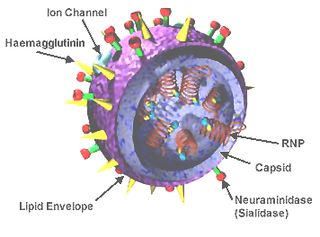
A universal flu vaccine is a flu vaccine that is effective against all influenza strains regardless of the virus sub type, antigenic drift or antigenic shift. Hence it should not require modification from year to year. As of 2019 there has been no approved universal flu vaccine for general use, but several have been in development.
Gary J. Nabel, M.D., Ph.D, is an American virologist and immunologist, and President and Chief Executive Officer of ModeX Therapeutics in Natick, Massachusetts.
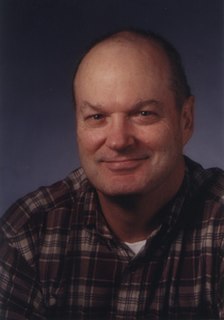
Brian R. Murphy is an American virologist and former co-chief of the Laboratory of Infectious Diseases at the National Institute of Allergy and Infectious Disease.
References
- ↑ Fiers W, De Filette M, Birkett A, Neirynck S, Min Jou W, A universal human influenza A vaccine, Virus Res. 2004 Jul;103(1-2):173-6
- ↑ Neirynck S, Deroo T, Saelens X, Vanlandschoot P, Jou WM, Fiers W, A universal influenza A vaccine based on the extracellular domain of the M2 protein, Nat Med. 1999 Oct;5(10):1157-63
- ↑ Saelens X, Vanlandschoot P, Martinet W, Maras M, Neirynck S, Contreras R, Fiers W, Jou WM, Protection of mice against a lethal influenza virus challenge after immunization with yeast-derived secreted influenza virus hemagglutinin, Eur J Biochem 260, 166-175, 1999
- ↑ De Filette M, Min Jou W, Birkett A, Lyons K, Schultz B, Tonkyro A, Resch S, Fiers W, Universal influenza A vaccine: optimization of M2-based constructs, Virology. 2005 Jun 20;337(1):149-61
- ↑ De Filette M, Ramne A, Birkett A, Lycke N, Löwenadler B, Min Jou W, Saelens X, Fiers W, The universal influenza vaccine M2e-HBc administered intranasally in combination with the adjuvant CTA1-DD provides complete protection, Vaccine. 2006 Jan 30;24(5):544-51
- ↑ Fiers W, Neirynck S, Deroo T, Saelens X, Jou WM, Soluble recombinant influenza vaccines, Philos Trans R Soc Lond B Biol Sci. 2001 Dec 29;356(1416):1961-3